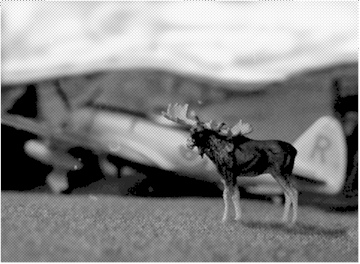An Almost Forgotten Story About P-47 Thunderbolt in SwAF Service
by Björn Goldman
This is the story about the Swedish J 27 Åskbollen. During the past 50 years, it has been one of the many classified and undisclosed stories of the Swedish Air Force. In fact, all but one very old person had totally forgotten all about it. Until now, that is.
During the mid-1940s, Sweden found itself in critical need of modern combat aircraft. In October 1944, Swedish officers went to England to study possible fighters that could be obtained. The Americans proved willing to sell and the Swedes made a formal request for the possible purchase of P-51D Mustangs and/or P-47 Thunderbolts. In February of 1945, a letter of intent was signed for the purchase of fifty fighters stored in England. Later that spring 50 Mustangs were delivered and stationed at the F16 wing in Uppsala. The Mustangs were given Swedish designation J 26.
The intention was to equip F4 at Frösön in northern Sweden with Mustangs as well. However, in 1945, it was reported that the officers of the north preferred the more ”portly” Thunderbolt. In comparison, the Mustangs looked like sissy aircraft – which could be OK for southerners and city folks, but not for the people of the North. They demanded an aircraft that could land in country ”where there were no roads”. Moreover, rumour has it that the wife of the officer in charge of Air Force negotiations had a figure that was quite reminiscent of the P-47…
The lieutenant who had left for Paris in the beginning of 1946 to negotiate a deal for further deliveries of Mustangs had to be rerouted to the Republic factory in Evansville, Indiana. The new mission was to purchase Thunderbolts for the F4 wing. Forty surplus aircraft were selected and ordered. Most of them were sadly in more or less derelict state and were thus handed over free of charge. The aircraft portrayed in this article, however, was a brand new plane produced at the Evansville factory and never used in service (and, sic, without any sign of weathering!).
The aircraft arrived in Sweden on April 1, 1946, receiving the official designation of J 27 Åskbollen, but was nick-named ”Dunderbult” by the Swedes. Despite strict orders from headquarters that the Åskbollen was only to be used as a fighter aircraft, the officers at F4 could not refrain themselves from using it as a bomber (even inofficially renaming it it from ”J 27” to ”B 27”). The military headquarters got mighty crossed, and threatened to take back the aircraft, should the officers not ”stop screwing around” with them…
The final blow for Åskbollen was, however, when a local newspaper revealed that the aircraft had been repeatedly used for hunting elk in the northern woods. The explanation given by the natives (i.e. that nothing else could bring down the Mighty Moose of the north) was ignored. There was even a photo in one of the papers of a P-47 – all dirty with broken off branches of trees etc – with the corps of a large animal displayed on the hood of the aircraft.
The only known existing photo of the real aircraft
from the archives of newspaper Östersundsposten.
Headquarters did everything to silence the story and conducted one of the most extensive cover-up operations in Swedish history (the official story was that F4 also received Mustangs!). The last Swedish Åskbollen flew in March 1956. After the service, most were molten down and the metal became dental braces for the spoiled kids of the 1960s. Rumour has it – however – that a few aircraft were saved. It is said that during hunting season, one can sometimes hear the thunderous roar of giant Double Wasp engines.This was one of my first builds – Hasegawa’s P-47D in 1/72, some odd decals and my first try with Alclad II. I finished it about a year ago. I’m pretty sure that it was on April 1st, too…
This article was originally published in IPMS stockholm Magazine in March 2006



